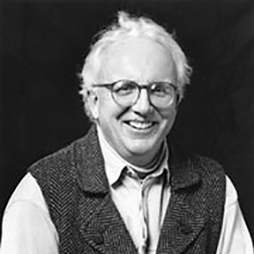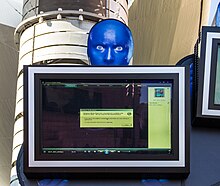
Robert Charles Venturi Jr. was an American architect, founding principal of the firm Venturi, Scott Brown and Associates, and one of the major architectural figures of the twentieth century.
The year 1991 in architecture involved some significant architectural events and new buildings.
The year 1972 in architecture involved some significant architectural events and new buildings.
The Hacienda was a hotel and casino on the Las Vegas Strip in Paradise, Nevada, that operated from 1956 to 1996. It was opened by Warren Bayley, who owned other Hacienda properties in California as well. Bayley opened the hotel portion in June 1956, although the opening of the casino was delayed as the Nevada Gaming Control Board objected to his choice of casino manager, Jake Kozloff. The casino portion eventually opened on October 17, 1956. The $6 million property had 266 rooms and the largest pool on the Las Vegas Strip. Like its sister properties in California, the resort included a neon sign that depicted a cowboy riding a palomino horse.

Postmodern architecture is a style or movement which emerged in the 1960s as a reaction against the austerity, formality, and lack of variety of modern architecture, particularly in the international style advocated by Philip Johnson and Henry-Russell Hitchcock. The movement was introduced by the architect and urban planner Denise Scott Brown and architectural theorist Robert Venturi in their book Learning from Las Vegas. The style flourished from the 1980s through the 1990s, particularly in the work of Scott Brown & Venturi, Philip Johnson, Charles Moore and Michael Graves. In the late 1990s, it divided into a multitude of new tendencies, including high-tech architecture, neo-futurism, new classical architecture and deconstructivism. However, some buildings built after this period are still considered post-modern.

The Desert Inn, also known as the D.I., was a hotel and casino on the Las Vegas Strip in Paradise, Nevada, which operated from April 24, 1950, to August 28, 2000. Designed by architect Hugh Taylor and interior design by Jac Lessman, it was the fifth resort to open on the Strip, the first four being El Rancho Vegas, The New Frontier, the still-operating Flamingo, and the now-defunct El Rancho. It was situated between Desert Inn Road and Sands Avenue.

The Yale School of Architecture (YSOA) is one of the constituent professional schools of Yale University, and is generally considered to be one of the best architecture schools in the United States. The School awards the degrees of Master of Architecture I, Master of Architecture II, Master of Environmental Design (M.E.D), and Ph.D in architectural history and criticism. The School also offers joint degrees with the Yale School of Management and Yale School of the Environment, as well as a course of study for undergraduates in Yale College leading to a Bachelor of Arts. Since its founding as a department in 1916, the School has produced some of the world's leading architects, including Norman Foster, Richard Rogers, Maya Lin and Eero Saarinen, among others. The current dean of the School is Deborah Berke.

Deconstructivism is a movement of postmodern architecture which appeared in the 1980s. It gives the impression of the fragmentation of the constructed building, commonly characterised by an absence of obvious harmony, continuity, or symmetry. Its name is a portmanteau of Constructivism and "Deconstruction", a form of semiotic analysis developed by the French philosopher Jacques Derrida. Architects whose work is often described as deconstructivist include Zaha Hadid, Peter Eisenman, Frank Gehry, Rem Koolhaas, Daniel Libeskind, Bernard Tschumi, and Coop Himmelb(l)au.

Denise Scott Brown is an American architect, planner, writer, educator, and principal of the firm Venturi, Scott Brown and Associates in Philadelphia. Scott Brown and her husband and partner, Robert Venturi, are regarded as among the most influential architects of the twentieth century, both through their architecture and planning, and theoretical writing and teaching.

The Big Duck is a ferrocement building in the shape of a duck located in Flanders, New York, on Long Island. It was originally built in 1931 by duck farmer Martin Maurer in nearby Riverhead, and used as a shop to sell ducks and duck eggs. It was added to the National Register of Historic Places in 1997. It is a principal building on the Big Duck Ranch, listed on the National Register of Historic Places in 2008.

Houston Hall is the student union of the University of Pennsylvania, in Philadelphia, Pennsylvania. Completed in 1896, it was the first student union built on an American college campus.
Steven Phillip Song is a Korean-American architect and real estate investor. Song, as a founding principal of the design firm SCAAA, first came to recognition through collaborations with his mentors, the architects and theoreticians Robert Venturi and Denise Scott Brown. Song is also the CEO of Axle Companies, a family office that invests in real estate and food companies. Song is on the Board of Directors of the Hammer Museum, the Executive Council of the Clinton Foundation Health Access Initiative, and the Board of Trustees of SCI-Arc.

The Vanna Venturi House, one of the first prominent works of the postmodern architecture movement, is located in the neighborhood of Chestnut Hill in Philadelphia, Pennsylvania. It was designed by architect Robert Venturi for his mother, Vanna Venturi, and constructed between 1962 and 1964.

Steven Izenour was an American architect, urbanist and theorist. He is best known as co-author, with Robert Venturi and Denise Scott Brown, of Learning from Las Vegas, one of the most influential architectural theory books of the twentieth century. He was also a principal in the Philadelphia firm Venturi, Scott Brown & Associates.

Guild House is a residential building in Philadelphia which is an important and influential work of 20th-century architecture and was the first major work by Robert Venturi. Along with the Vanna Venturi House it is considered to be one of the earliest expressions of Postmodern architecture, and helped establish Venturi as one of the leading architects of the 20th century.
The following is a timeline of the history of the city of Las Vegas, Nevada, United States. The Spanish Trader Antonio Armijo led a 60-man party along the Spanish Trail to Los Angeles, California in 1829 and found a natural steam water Land that was named Las Vegas.

Marion Boulton Stroud, also known as Marion Stroud Swingle was an American curator, author, and museum director who was particularly active in her support of contemporary art, and of the use of textiles as a medium. She was the founder and director of The Fabric Workshop and Museum in Philadelphia, Pennsylvania, and a trustee and active supporter of the Philadelphia Museum of Art. She is commonly referred to as "Kippy".

Learning from Las Vegas is a 1972 book by Robert Venturi, Denise Scott Brown, and Steven Izenour. Translated into 18 languages, the book helped foster the development of postmodern architecture.

Caesars Palace is a luxury hotel and casino in Paradise, Nevada, United States. The hotel is situated on the west side of the Las Vegas Strip between Bellagio and The Mirage. It is one of Las Vegas's largest and best known landmarks.

Delirious New York: A Retroactive Manifesto for Manhattan is a 1978 book, written by Dutch architect Rem Koolhaas. The book serves as a retroactive manifesto for Manhattan between 1850 and 1960, analyzing the development of architecture and urban design throughout New York's history from the founding of New Amsterdam by the Dutch, to the design of the Headquarters of the United Nations by Le Corbusier. Rem Koolhaas describes the concept of 'Manhattanism', the theory of the creation and functioning of the city of New York, at length in the book.
















